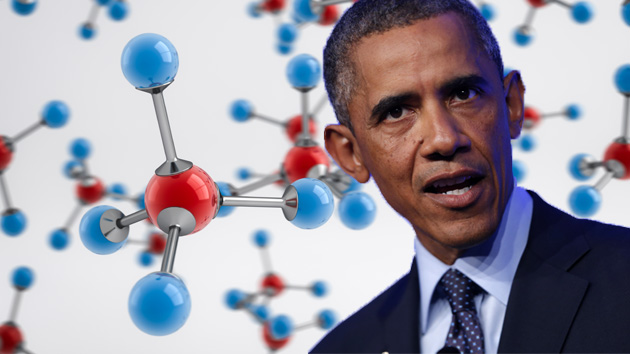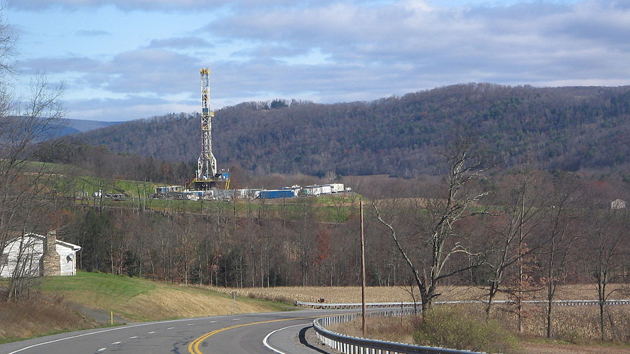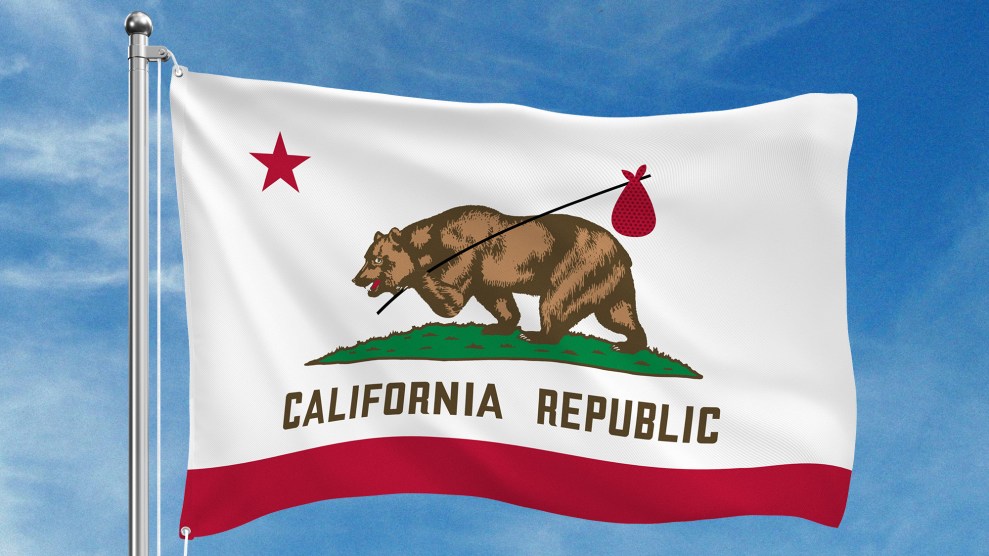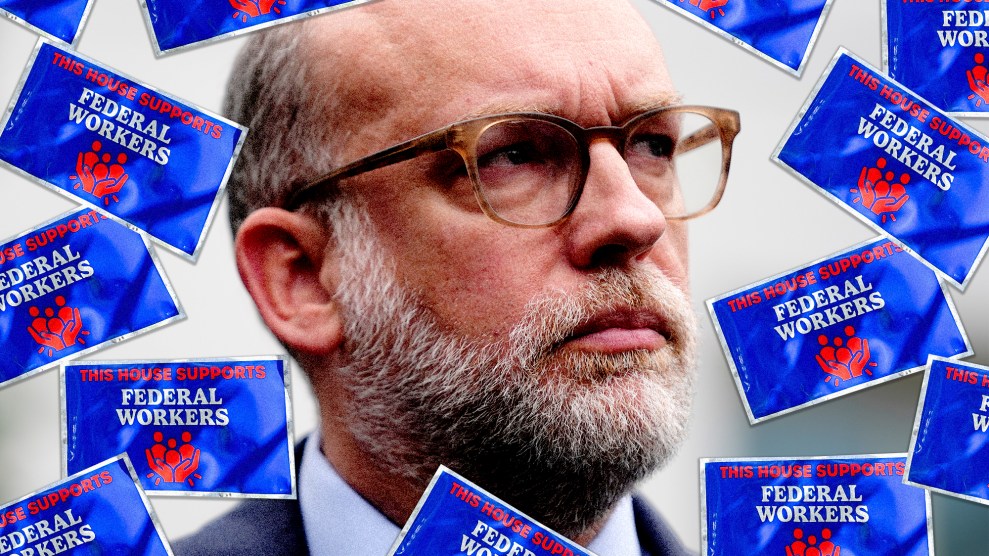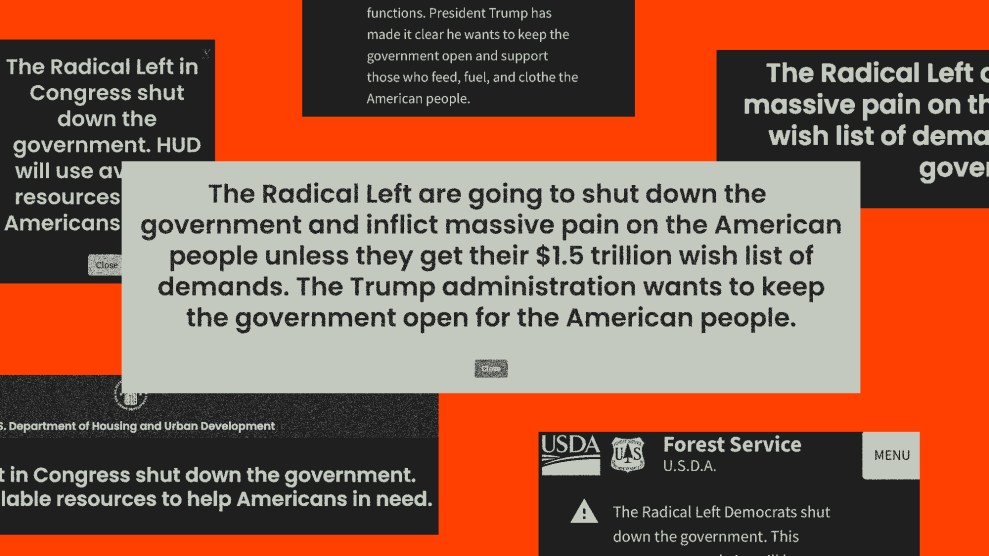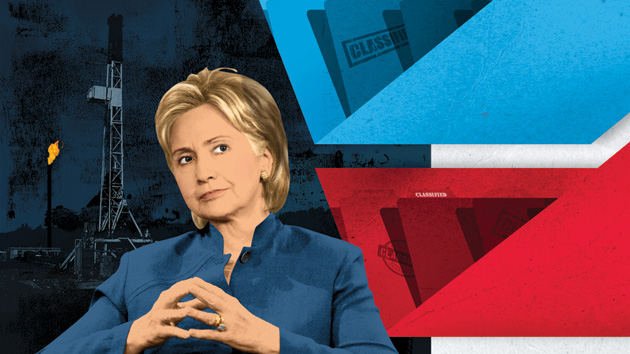
Illustration by John Ritter
One icy morning in February 2012, Hillary Clinton’s plane touched down in the Bulgarian capital, Sofia, which was just digging out from a fierce blizzard. Wrapped in a thick coat, the secretary of state descended the stairs to the snow-covered tarmac, where she and her aides piled into a motorcade bound for the presidential palace. That afternoon, they huddled with Bulgarian leaders, including Prime Minister Boyko Borissov, discussing everything from Syria’s bloody civil war to their joint search for loose nukes. But the focus of the talks was fracking. The previous year, Bulgaria had signed a five-year, $68 million deal, granting US oil giant Chevron millions of acres in shale gas concessions. Bulgarians were outraged. Shortly before Clinton arrived, tens of thousands of protesters poured into the streets carrying placards that read “Stop fracking with our water” and “Chevron go home.” Bulgaria’s parliament responded by voting overwhelmingly for a fracking moratorium.
Clinton urged Bulgarian officials to give fracking another chance. According to Borissov, she agreed to help fly in the “best specialists on these new technologies to present the benefits to the Bulgarian people.” But resistance only grew. The following month in neighboring Romania, thousands of people gathered to protest another Chevron fracking project, and Romania’s parliament began weighing its own shale gas moratorium. Again Clinton intervened, dispatching her special envoy for energy in Eurasia, Richard Morningstar, to push back against the fracking bans. The State Department’s lobbying effort culminated in late May 2012, when Morningstar held a series of meetings on fracking with top Bulgarian and Romanian officials. He also touted the technology in an interview on Bulgarian national radio, saying it could lead to a fivefold drop in the price of natural gas. A few weeks later, Romania’s parliament voted down its proposed fracking ban and Bulgaria’s eased its moratorium.
The episode sheds light on a crucial but little-known dimension of Clinton’s diplomatic legacy. Under her leadership, the State Department worked closely with energy companies to spread fracking around the globe—part of a broader push to fight climate change, boost global energy supply, and undercut the power of adversaries such as Russia that use their energy resources as a cudgel. But environmental groups fear that exporting fracking, which has been linked to drinking-water contamination and earthquakes at home, could wreak havoc in countries with scant environmental regulation. And according to interviews, diplomatic cables, and other documents obtained by Mother Jones, American officials—some with deep ties to industry—also helped US firms clinch potentially lucrative shale concessions overseas, raising troubling questions about whose interests the program actually serves.
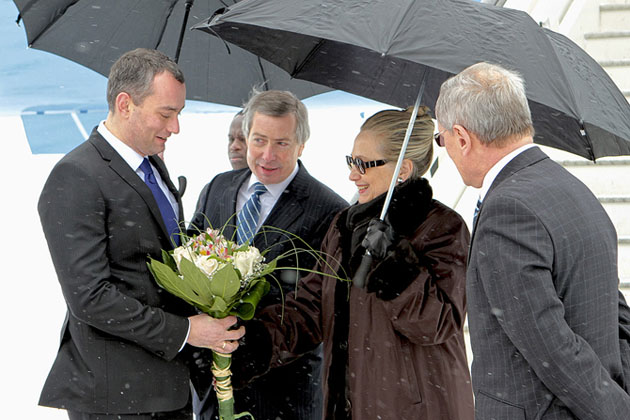
Geologists have long known that there were huge quantities of natural gas locked in shale rock. But tapping it wasn’t economically viable until the late 1990s, when a Texas wildcatter named George Mitchell hit on a novel extraction method that involved drilling wells sideways from the initial borehole, then blasting them full of water, chemicals, and sand to break up the shale—a variation of a technique known as hydraulic fracturing, or fracking. Besides dislodging a bounty of natural gas, Mitchell’s breakthrough ignited an energy revolution. Between 2006 and 2008, domestic gas reserves jumped 35 percent. The United States later vaulted past Russia to become the world’s largest natural gas producer. As a result, prices dropped to record lows, and America began to wean itself from coal, along with oil and gas imports, which lessened its dependence on the Middle East. The surging global gas supply also helped shrink Russia’s economic clout: Profits for Russia’s state-owned gas company, Gazprom, plummeted by more than 60 percent between 2008 and 2009 alone.
Clinton, who was sworn in as secretary of state in early 2009, believed that shale gas could help rewrite global energy politics. “This is a moment of profound change,” she later told a crowd at Georgetown University. “Countries that used to depend on others for their energy are now producers. How will this shape world events? Who will benefit, and who will not?…The answers to these questions are being written right now, and we intend to play a major role.” Clinton tapped a lawyer named David Goldwyn as her special envoy for international energy affairs; his charge was “to elevate energy diplomacy as a key function of US foreign policy.”
Goldwyn had a long history of promoting drilling overseas—both as a Department of Energy official under Bill Clinton and as a representative of the oil industry. From 2005 to 2009 he directed the US-Libya Business Association, an organization funded primarily by US oil companies—including Chevron, Exxon Mobil, and Marathon—clamoring to tap Libya’s abundant supply. Goldwyn lobbied Congress for pro-Libyan policies and even battled legislation that would have allowed families of the Lockerbie bombing victims to sue the Libyan government for its alleged role in the attack.
According to diplomatic cables released by WikiLeaks, one of Goldwyn’s first acts at the State Department was gathering oil and gas industry executives “to discuss the potential international impact of shale gas.” Clinton then sent a cable to US diplomats, asking them to collect information on the potential for fracking in their host countries. These efforts eventually gave rise to the Global Shale Gas Initiative, which aimed to help other nations develop their shale potential. Clinton promised it would do so “in a way that is as environmentally respectful as possible.”
But environmental groups were barely consulted, while industry played a crucial role. When Goldwyn unveiled the initiative in April 2010, it was at a meeting of the United States Energy Association, a trade organization representing Chevron, Exxon Mobil, and ConocoPhillips, all of which were pursuing fracking overseas. Among their top targets was Poland, which preliminary studies suggested had abundant shale gas. The day after Goldwyn’s announcement, the US Embassy in Warsaw helped organize a shale gas conference, underwritten by these same companies (plus the oil field services company Halliburton) and attended by officials from the departments of State and Energy.
In some cases, Clinton personally promoted shale gas. During a 2010 gathering of foreign ministers in Washington, DC, she spoke about America’s plans to help spread fracking abroad. “I know that in some places [it] is controversial,” she said, “but natural gas is the cleanest fossil fuel available for power generation today.” She later traveled to Poland for a series of meetings with officials, after which she announced that the country had joined the Global Shale Gas Initiative.
That August, delegates from 17 countries descended on Washington for the State Department’s first shale gas conference. The media was barred from attending, and officials refused to reveal basic information, including which countries took part. When Rep. Henry Waxman (D-Calif.) inquired about industry involvement, the department would say only that there had been “a limited industry presence.” (State Department officials have since been more forthcoming with Mother Jones: In addition to a number of US government agencies, they say attendees heard from energy firms, including Devon, Chesapeake, and Halliburton.)
During the cursory press conference that followed, Goldwyn, a short, bespectacled man with a shock of dark hair, argued that other nations could avoid the environmental damage sometimes associated with fracking by following America’s lead and adopting “an umbrella of laws and regulations.” A reporter suggested that US production had actually “outpaced the ability to effectively oversee the safety” and asked how we could be sure the same wouldn’t happen elsewhere. Goldwyn replied that attendees had heard about safety issues from energy companies and the Groundwater Protection Council, a nonprofit organization that receives industry funding and opposes federal regulation of fracking wastewater disposal.
Goldwyn and the delegates then boarded a bus to Pennsylvania for an industry-sponsored luncheon and tour of some shale fields. Paul Hueper, director of energy programs at the State Department’s Bureau of Energy Resources, says the tour was organized independently and that energy firms were only invited to the conference itself to share best practices. “We are very firm on this,” he insisted. “We do not shill for industry.”
While the meeting helped stir up interest, it wasn’t until 2011 that global fracking fever set in for real. That spring, the US Energy Information Administration (EIA) released its initial estimate of global shale gas, which found that 32 countries had viable shale basins and put global recoverable shale gas at 6,600 trillion cubic feet—enough to supply the world for more than 50 years at current rates of consumption. This was a rich opportunity for big oil and gas companies, which had largely missed out on the US fracking boom and were under pressure from Wall Street to shore up their dwindling reserves. “They’re desperate,” says Antoine Simon, who coordinates the shale gas campaign at Friends of the Earth Europe. “It’s the last push to continue their fossil fuel development.”

The industry began fighting hard for access to shale fields abroad, and promoting gas as the fuel of choice for slashing carbon emissions. In Europe, lobbyists circulated a report claiming that the European Union could save 900 billion euros if it invested in gas rather than renewable energy to meet its 2050 climate targets. This rankled environmentalists, who argue fracking may do little to ease global warming, given that wells and pipelines leak large quantities of methane, a potent greenhouse gas. They also fear it could crowd out investment in renewables.
By early 2011, the State Department was laying plans to launch a new bureau to integrate energy into every aspect of foreign policy—an idea Goldwyn had long been advocating. In 2005, he and a Chevron executive named Jan Kalicki had published a book called Energy and Security: Toward a New Foreign Policy Strategy, which argued that energy independence was unattainable in the near term and urged Washington to shift its focus to energy security—by boosting global fossil fuel production and stifling unrest that might upset energy markets. Goldwyn and his ideas had played a key role in shaping the bureau, so some observers were surprised when he quietly stepped down just before its launch.
When I approached Goldwyn following a recent speaking engagement in Washington, DC, to ask about his time at the State Department and why he left, he ducked out a side door, and Kalicki blocked the corridor to keep me from following. Goldwyn later said via email that he had simply chosen “to return to the private sector.”
Around the time of his departure, WikiLeaks released a slew of diplomatic cables, including one describing a 2009 meeting during which Goldwyn and Canadian officials discussed development of the Alberta oil sands—a project benefiting some of the same firms behind the US-Libya Business Association. The cable said that Goldwyn had coached his Canadian counterparts on improving “oil sands messaging” and helped alleviate their concerns about getting oil sands crude to US markets. This embarrassed the State Department, which is reviewing the controversial Keystone XL pipeline proposal to transport crude oil from Canada and is under fire from environmentalists.
After leaving State, Goldwyn took a job with Sutherland, a law and lobbying firm that touts his “deep understanding” of pipeline issues, and launched his own company, Goldwyn Global Strategies.
In late 2011, Clinton finally unveiled the new Bureau of Energy Resources, with 63 employees and a multimillion-dollar budget. She also promised to instruct US embassies around the globe to step up their work on energy issues and “pursue more outreach to private-sector energy” firms, some of which had generously supported both her and President Barack Obama’s political campaigns. (One Chevron executive bundled large sums for Clinton’s 2008 presidential bid, for example.)
As part of its expanded energy mandate, the State Department hosted conferences on fracking from Thailand to Botswana. It sent US experts to work alongside foreign officials as they developed shale gas programs. And it arranged for dozens of foreign delegations to visit the United States to attend workshops and meet with industry consultants—as well as with environmental groups, in some cases.
US oil giants, meanwhile, were snapping up natural gas leases in far-flung places. By 2012, Chevron had large shale concessions in Argentina, Australia, Canada, China, and South Africa, as well as in Eastern Europe, which was in the midst of a claim-staking spree; Poland alone had granted more than 100 shale concessions covering nearly a third of its territory. When the nation lit its first shale gas flare atop a Halliburton-drilled well that fall, the state-owned gas company ran full-page ads in the country’s largest newspapers showing a spindly rig rising above the hills in the tiny village of Lubocino, alongside the tagline: “Don’t put out the flame of hope.” Politicians promised that Poland would soon break free of its nemesis, Russia, which supplies the lion’s share of its gas. “After years of dependence on our large neighbor, today we can say that my generation will see the day when we will be independent in the area of natural gas,” Prime Minister Donald Tusk declared. “And we will be setting terms.”

But shale was not the godsend that industry leaders and foreign governments had hoped it would be. For one, new research from the US Geological Survey suggested that the EIA assessments had grossly overestimated shale deposits: The recoverable shale gas estimate for Poland shrank from 187 trillion cubic feet to 1.3 trillion cubic feet, a 99 percent drop. Geological conditions and other factors in Europe and Asia also made fracking more arduous and expensive; one industry study estimated that drilling shale gas in Poland would cost three times what it does in the United States.
By 2013, US oil giants were abandoning their Polish shale plays. “The expectations for global shale gas were extremely high,” says the State Department’s Hueper. “But the geological limitations and aboveground challenges are immense. A handful of countries have the potential for a boom, but there may never be a global shale gas revolution.”
The politics of fracking overseas were also fraught. According to Susan Sakmar, a visiting law professor at the University of Houston who has studied fracking regulation, the United States is one of the only nations where individual landowners own the mineral rights. “In most, perhaps all, other countries of the world, the underground resources belong to the crown or the government,” she explains. The fact that property owners didn’t stand to profit from drilling on their land ignited public outrage in some parts of the world, especially Eastern Europe. US officials speculate that Russia also had a hand in fomenting protests there. “The perception among diplomats in the region was that Russia was protecting its interests,” says Mark Gitenstein, the former US ambassador to Romania. “It didn’t want shale gas for obvious reasons.”
Faced with these obstacles, US and European energy companies launched a lobbying blitz targeting the European Union. They formed faux grassroots organizations, plied lawmakers with industry-funded studies, and hosted lavish dinners and conferences for regulators. The website for one industry confab—which, according to Friends of the Earth Europe, featured presentations from Exxon Mobil, Total, and Halliburton—warned that failure to develop shale gas “will have damaging consequences on European energy security and prosperity” and urged European governments to “allow shale gas exploration to advance” so they could “fully understand the scale of the opportunity.”
US lobbying shops also jumped into the fray. Covington & Burling, a major Washington firm, hired several former senior EU policymakers—including a top energy official who, according to the New York Times, arrived with a not-yet-public draft of the European Commission’s fracking regulations.
In June 2013, Covington staffer Jean De Ruyt, a former Belgian diplomat and adviser to the European Commission, hosted an event at the firm’s Brussels office. Executives from Chevron and other oil and gas behemoths attended, as did Kurt Vandenberghe, then one of the commission’s top environmental regulators. These strategies appeared to pay off: The commission’s recently released framework for regulating fracking includes recommendations for governments but not firm requirements. “They chose the weakest option they had,” says Simon of Friends of the Earth Europe. “People at the highest level of the commission are in the industry’s pocket.”
Goldwyn was also busy promoting fracking overseas—this time on behalf of industry. Between January and October 2012, his firm organized a series of workshops on fracking for officials in Bulgaria, Lithuania, Poland, Romania, and Ukraine, all of them funded by Chevron. The events were closed to the public—when Romanian journalist Vlad Ursulean tried to attend the Romanian gathering, he says Goldwyn personally saw to it that he was escorted out.

Goldwyn told Mother Jones that the workshops featured presentations on technical aspects of fracking by academics from the Colorado School of Mines and Penn State University. Chevron, he maintains, had “no editorial input.” But all of these countries—except Bulgaria, which was in the midst of anti-fracking protests—would later grant Chevron major shale concessions.
In some cases, the State Department had a direct hand in negotiating the deals. Gitenstein, then the ambassador to Romania, met with Chevron executives and Romanian officials and pressed them to hand over millions of acres of shale concessions. “The Romanians were just sitting on the leases, and Chevron was upset. So I intervened,” says Gitenstein, whose State Department tenure has been bookended by stints at Mayer Brown, a law and lobbying firm that has represented Chevron. “This is traditionally what ambassadors do on behalf of American companies.” In the end, Romania signed a 30-year deal with Chevron, which helped set off massive, nationwide protests.
When the government began weighing a fracking ban, it didn’t sit well with Gitenstein, who went on Romanian television and warned that, without fracking, the nation could be stuck paying five times what America does for natural gas. He added that US shale prospectors had “obtained great successes—without consequences for the environment, I dare say.” The proposed moratorium soon died.
A few weeks later, Chevron was preparing to build its first fracking rig near Pungesti, a tiny farming village in northeastern Romania. According to a memo from the prime minister’s office, a Romanian official met with Chevron executives and an embassy-based US Commerce Department employee to craft a PR strategy for the project. They agreed to organize a kickoff event at Victoria Palace in Bucharest. As a spokesman, they would tap Damian Draghici, a charismatic Romanian lawmaker who was a “recognized personality among the Roma minority,” which had a “considerable presence” around Chevron’s planned drilling sites. “It was really extraordinary—the level of collaboration between these players,” says Ursulean, who has written extensively about Chevron’s activities in Romania. “It was as if they were all branches of the same company.”
The strategy did little to soothe the public’s ire. When Chevron finally did attempt to install the rig in late 2013, residents—including elderly villagers who arrived in horse-drawn carts—blockaded the planned drilling sites. The Romanian Orthodox Church rallied behind them, with one local priest likening Chevron to enemy “invaders.” Soon, anti-fracking protests were cropping up from Poland to the United Kingdom. But Chevron didn’t back down. Along with other American energy firms, it lobbied to insert language in a proposed US-EU trade agreement allowing US companies to haul European governments before international arbitration panels for any actions threatening their investments. Chevron argued this was necessary to protect shareholders against “arbitrary” and “unfair” treatment by local authorities. But environmental groups say it would stymie fracking regulation and point to a $250 million lawsuit Delaware-based Lone Pine Resources has filed against the Canadian province of Quebec for temporarily banning fracking near a key source of drinking water. The case hinges on a similar trade provision.
Despite the public outcry in Europe, the State Department has stayed the course. Clinton’s successor as secretary of state, John Kerry, views natural gas as a key part of his push against climate change. Under Kerry, State has ramped up investment in its shale gas initiative and is planning to expand it to 30 more countries, from Cambodia to Papua New Guinea.
Following the Crimea crisis, the Obama administration has also been pressing Eastern European countries to fast-track their fracking initiatives so as to be less dependent on Russia. During an April visit to Ukraine, which has granted concessions to Chevron and Royal Dutch Shell, Vice President Joe Biden announced that the United States would bring in technical experts to speed up its shale gas development. “We stand ready to assist you,” promised Biden, whose son Hunter has since joined the board of a Ukrainian energy company. “Imagine where you’d be today if you were able to tell Russia: ‘Keep your gas.’ It would be a very different world.”
This story was supported by the Fund for Investigative Journalism.
